

Authentic Assessment & Engagement. Anti-Cheating. Plagiarism and Proctoring. Assessment / BioSig-ID. Study: Instructor Quality Clearly an Important Factor in Student Success. Teaching & Learning Study: Instructor Quality 'Clearly' an Important Factor in Student Success By Dian Schaffhauser01/17/17 A project led by three researchers at the University of Michigan has attempted to tease out the impact of individual instructor effectiveness in colleges and universities.
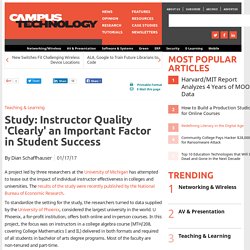
The results of the study were recently published by the National Bureau of Economic Research. To standardize the setting for the study, the researchers turned to data supplied by the University of Phoenix, considered the largest university in the world. The courses themselves are highly structured. About 60 math sections are started every week, and instructors are allocated to them randomly. Typically, instructors are hired through a main committee, which checks that the candidate has the right degree. To track teacher performance, U Phoenix requires its instructors to take a yearly refresher course on teaching methods.
Learning Analytics - Whats Your First Step? Classroom Assessment Tech Tools. IMS Global Learning Consortium. A growing number of learning interactions take place online, which allows for data and information specific to the learning activity to be captured.
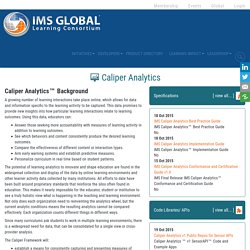
This data promises to provide new insights into how particular learning interactions relate to learning outcomes. Using this data, educators can: Answer those seeking more accountability with measures of learning activity in addition to learning outcomes. See which behaviors and content consistently produce the desired learning outcomes. Compare the effectiveness of different content or interaction types. Why Is Measuring Learning So Difficult? A Simple DIY Approach to Tracking and Improving Student Learning Outcomes. The Biggest Movers: 2015 Eduventures Retention Ratings. By Heather O’Leary, Principal Analyst In a previous Wake-Up Call, “It’s Time to Get Real About Retention,” we discussed the development of the 2013 Eduventures Retention Ratings.
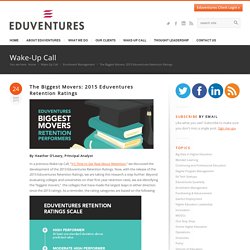
Now, with the release of the 2015 Eduventures Retention Ratings, we are taking this research a step further. Beyond evaluating colleges and universities on their first year retention rates, we are identifying the “biggest movers,” the colleges that have made the largest leaps in either direction since the 2013 ratings. As a reminder, the rating categories are based on the following: Many will be surprised by this list of big movers. It should also be noted that the biggest movers demonstrate that it is possible to transform your retention in either direction within just a few years. Games, Badges, and Tests, Oh My! By Brian Fleming, Senior Analyst With hundreds of schools flocking to competency-based education (CBE), a surge in tools and technologies is infusing this market.
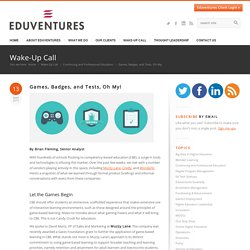
Over the past few weeks, we met with a number of vendors playing actively in this space, including Muzzy Lane, Credly, and Wonderlic. Here’s a snapshot of what we learned through formal product briefings and informal conversations with execs from these companies. Let the Games Begin CBE should offer students an immersive, scaffolded experience that makes extensive use of interactive learning environments, such as those designed around the principles of game-based learning. We spoke to David Martz, VP of Sales and Marketing at Muzzy Lane. Bring on the Badges Credly, a digital badging management company, recently garnered attention through its partnership with Brandman University, an innovative adult-serving school that is now approved to offer CBE through direct assessment. Three Key Questions to Shape Your Enrollment Strategy. By Senior Analysts, Mark Rooney and Rachel Smooke Institutions today have unprecedented access to data.
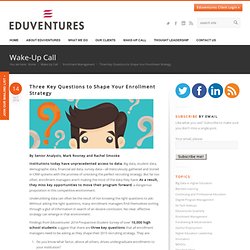
Big data, student data, demographic data, financial aid data, survey data—all meticulously gathered and stored in CRM systems with the promise of unlocking the perfect recruiting strategy. But far too often, enrollment managers aren’t making the most of the data they have. As a result, they miss key opportunities to move their program forward, a dangerous proposition in this competitive environment. Underutilizing data can often be the result of not knowing the right questions to ask. Findings from Eduventures’ 2014 Prospective Student Survey of over 10,000 high school students suggest that there are three key questions that all enrollment managers need to be asking as they shape their 2015 recruiting strategy. Do you know what factor, above all others, drives undergraduate enrollments to your institution? Question 1. Answer: Career preparation. Question 2. Question 3. 10 tips for deploying a new assessment platform (differently) Time and again, institutions struggle with properly deploying a new assessment platform.

Often that fault lies with the vendor who lacks the knowledge or institutional expertise to provide sound counsel on how it should be accomplished. Take a different approach and it will be a success: 1. Separate orientation and training. Retention Ratings - Eduventures. Searchlights and sunglasses: Field notes from the digital age of journalism. Www.whitehouse.gov/sites/default/files/microsites/ostp/big_data_fact_sheet_final_1.pdf. The Social Life of Big Data and Algorithms. Abstract This study looks at the history of the hyperlink from a medium-specific perspective by analyzing the technical reconfiguration of the hyperlink by engines and platforms over time.
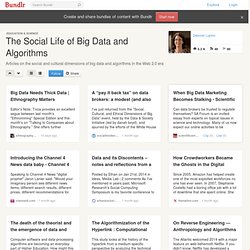
Hyperlinks may be seen as having different roles belonging to specific periods, including the role of the hyperlink as a unit of navigation, a relationship marker, a reputation indicator and a currency of the web. The question here is how web devices have contributed to constituting these roles and how social media platforms have advanced the hyperlink from a navigational device into a data-rich analytical device.